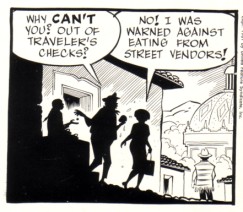Latest Gear Live Videos
Wednesday May 26, 2010 2:23 am
Gus Arriola and Gordo
 I never got to read Gordo when it was syndicated - it never ran in any papers in my area when I was a kid. It was always a strip that I read about, instead of actually reading. That changed as I got older and got to read longer runs of of it. It deserves all the praise it gets for its gentle humor and its brilliant design. You can read comics on the iPhone all day long, but it’s one panel at a time. To appreciate the craftsmanship of a Gordo strip, you need to take in the whole thing. The guy was just great, and he deserved a much wider audience and he deserves to be read and experienced still today. With comics in this Golden Age period of archival reprint heaven - c’mon, even Gasoline Alley is getting collected - Gordo should be right there with everyone else. (I’m looking at you, Dean Mullaney)!
I never got to read Gordo when it was syndicated - it never ran in any papers in my area when I was a kid. It was always a strip that I read about, instead of actually reading. That changed as I got older and got to read longer runs of of it. It deserves all the praise it gets for its gentle humor and its brilliant design. You can read comics on the iPhone all day long, but it’s one panel at a time. To appreciate the craftsmanship of a Gordo strip, you need to take in the whole thing. The guy was just great, and he deserved a much wider audience and he deserves to be read and experienced still today. With comics in this Golden Age period of archival reprint heaven - c’mon, even Gasoline Alley is getting collected - Gordo should be right there with everyone else. (I’m looking at you, Dean Mullaney)!
Continuing my series on cartooning and cartoonists, Gus wrote about himself and his work back in 1964. This is pulled from an oversized saddle-stitched magazine from Allied Publications with the creatively-challenged title These Top Cartoonists Tell How They Create America’s Favorite Comics. It featured an introduction by Beetle Bailey’s Mort Walker and was compiled by Allen Willette.
Here’s Gus on Gus and Gordo:
 “I was born in the northern part of Mexico, now known as Arizona, July 23, 1917. I was reared in Los Angeles, California and was graduated from high school directly into the MGM Cartoon Department as a story-sketch man on the Tom and Jerry cat and mouse series. That was in 1937. I created and sold Gordo, June 1941, to United Feature Syndicate.
“I was born in the northern part of Mexico, now known as Arizona, July 23, 1917. I was reared in Los Angeles, California and was graduated from high school directly into the MGM Cartoon Department as a story-sketch man on the Tom and Jerry cat and mouse series. That was in 1937. I created and sold Gordo, June 1941, to United Feature Syndicate.
“Ten months after Pearl Harbor, I joined the Army Air Force’s Motion Picture Unit where I spent three and a half years making animated training films. A post-war search for an ideal home led me from Los Angeles to La Jolla, California for three years, thence to Phoenix, Arizona for five…then I finally found it in Carmel, California where I’ve settled in an old redwood house by the beach, with my wife Frances, my swinging son, Carlin, and Smelly Dave, the funniest, most charming of countless cats we’ve owned. I’m interested in good everything: music, books, food, wine, friends and times.
“I work alone on story and art. Consequently I lack enough time to enjoy all the good. My working habits are sporadic. I spend from six to sometimes twelve hours a day in my studio at home. My mind works twenty-four hours a day.
“I rough out strips and Sunday pages on tissue and ink them in over a light board. I like to vary material from nutty continuities or social satires, to single, daily gags. Sunday pages are my favorites. I love color. I try to work color and design into the Sunday pages to help ease my frustrations at not having the time to paint.”
What a life - he went right from high school into animation, and then sold Gordo to the syndicate when he was 24.
Comics historian R. C. Harvey wrote the definitive book on Arriola, called Accidental Ambassador Gordo: The Comic Strip Art of Gus Arriola.
Tom Spurgeon wrote a nice obituary of Arriola when he passed away in 2008.
Comic Strip Fan has a couple of beautiful Gordo dailies and a Sunday page with its color guide.
Here’s a black and white Sunday page, shot from the original art.
Arriola’s Wikipedia entry also has a great Gordo Sunday page.
According to Don Markstein’s Toonopedia, there was a time when Arriola was out sick and both Playboy cartoonist Eldon Dedini and Dennis The Menace creator Hank Ketcham pitched in on the strip. Somebody please put those online!
Hogan’s Alley, the comic strip magazine run by my old pal Tom Heintjes, has a John Province interview with Arriola that while not definitive in The Comics Journal sense, is still a great read. I was fascinated by this comment from Arriola about the financials of that era of comic strips: “In those days you didn’t look at the money because you didn’t have anything to bargain with. It was 50 percent of the net, and that was based on the number of papers they could sell it to. A big-city paper might pay $150 a week, and a rural paper, $3.50 a week.”
Coming up next in this series: yet another old-school cartoonist!
[Artwork: photograph of Arriola from the 1964 publication (top); panel from Gordo (bottom)]
Advertisement
Advertisement
Advertisement
© Gear Live Media, LLC. 2007 – User-posted content, unless source is quoted, is licensed under a Creative Commons Public Domain License. Gear Live graphics, logos, designs, page headers, button icons, videos, articles, blogs, forums, scripts and other service names are the trademarks of Gear Live Inc.












Comments: